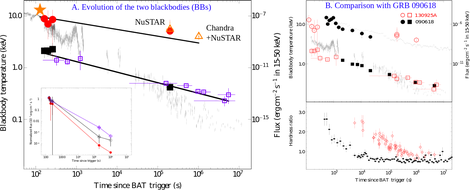
On September 25, 2013 NASA explorer Swift detected a GRB, named 130925A, having the longest ever prompt gamma-ray emission. This GRB was categorized as an ultra-long GRB, a special category of GRB whose progenitors are believed to be blue supergiants. The afterglow in X-rays showed a very unusual softening of the spectrum at least till eleven days. Piro et al. (2014), using the Swift XRT data, found a significant thermal emission, and explained the spectral softening as due to the temperature evolution of a blackbody. Evans et al. (2014), on the other hand, using the same data provided an alternate explanation for the spectral softening as due to dust scattering, and they suggested it occurs in all ultra-long GRBs. The matter gets even more complicated by a target of opportunity observation of NuSTAR and Chandra which, though confirmed the existence of a thermal component in the spectrum, measured the temperature to be ~ 5 keV (Bellm et al. 2014), an order of magnitude higher than the temperature measured by the contemporaneous XRT data (~ 0.5 keV; Piro et al. 2014).
Interestingly, in recent years Rupal Basak (CAMK, Warsaw) and A. R. Rao (TIFR, Mumbai) with other colleagues have found evidences of two blackbody components during the prompt gamma-ray emission of different GRBs (Basak & Rao 2013, 2014, Rao et al. 2014). The multiple blackbodies seen in GRB~130925A, Basak & Rao argue, are manifestations of the generic spectral components of two black bodies and a power law (the 2BBPL model), identified in the prompt emission of many GRBs. At late times, these blackbodies cool and they are observable in the high spectral resolution detectors like XRT and NuSTAR.
In the left panel of the figure, the blackbody temperatures, as measured by Piro et al. are plotted as open squares and they show a neat power-law decay as a function of time (GRB flux shown as background grey points). The temperatures measured by Belm et al. (shown as open triangles) stand apart from these values, as a sore thumb. Basak & Rao re-analysed the data showing that both blackbodies co-exist: the lower blackbody was interpreted as an absorbed steep power-law by Belm et al., whereas, the data used by Piro et al (XRT) are insensitive to the higher temperature blackbody. They went back to the early emission of this GRB and made a spectral analysis also using the Swift BAT data. Simultaneous fitting of the BAT and XRT data at early times showed the existence of two black bodies (filled symbols in the figure). A consistent picture of two blackbodies cooling with time emerged from the analysis.
Basak & Rao propose that these thermal emissions are produced in the two photospheres of a structured GRB jet where a fast moving spine is surrounded by a slower sheath. Such a jet structure is theoretically expected as the GRB jet pierces through the envelop of the dying progenitor. A further comparison of the spectral evolution with GRB 090618, a typical long GRB shows a very similar evolution (right panel), which disfavours the dust scattering model for ultra-long GRBs. The time axis of GRB 090618 is arbitrarily stretched to show the similarity. For the ultra-long GRB 130925A, this also indicates a longer time scale of the spectral evolution, larger size of the progenitor and longer activity of the central engine.
The paper ``Thermal Emissions Spanning the Prompt and the Afterglow Phase of the Ultra-long GRB 130925A''containing these results is accepted for publication by the Astrophysical Journal.






